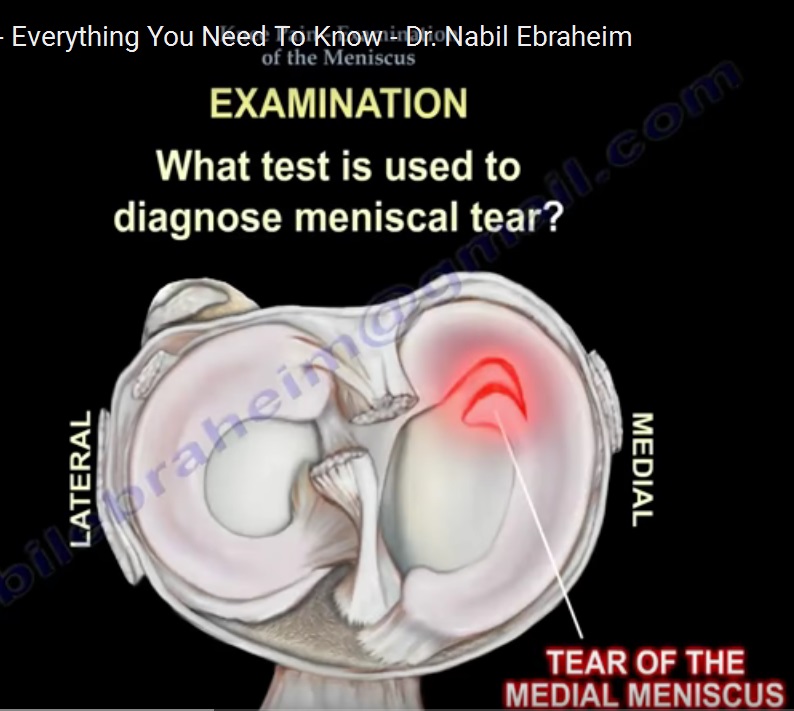Courtesy: Prof Nabil Ebraheim
University of Toledo, Ohio, USA
Knee pain – examination of meniscus
- Meniscus is a fibrocartilage structure that carries type 1 collagen.
- Meniscus is triangular shaped in cross section
LATERAL MENISCUS: circular, covers 70% of lateral tibial plateau. More mobile than the medial meniscus.
MEDIAL MENISCUS: C-shaped, covers 50% of medial tibial plateau. Medial meniscal tears occurs about three times more often than that of lateral meniscus.
Function :
- Shock absorption
- Load sharing
- Joint stability
Meniscal tear causes:
- Jumping, twisting or changing directions during sports activities such as skiing or football.
Degenerative tears of the medial meniscus may occur in older patients
Degenerative tears may also occur in association with arthritis.
Symptoms of meniscal injury
- Pain on the medial or lateral side of the knee
- Mechanical symptoms: Locking
- Clicking
- Swelling
Examination
- Joint line tenderness is the most sensitive exam
- Posterior knee pain may also be present especially when the knee is bent
- Look for knee joint effusion : effusion maybe difficult to find and occur several hours to appear after the injury
- With ACL tears, the hemorrhage and swelling is greater and develops rapidly.
What Test is used to diagnose meniscal tear ?
- Mcmurrays test – painful pop or click is obtained as the knee is brought from flexion to extension with either internal or external rotation of the knee.
- The knee is then external rotated and extended in order to test the medial meniscus. A pop or click felt with knee extension. The patient will experience pain.
- A positive test is indicated by pain, clicking or popping within the joint and may signal a tear of the medial meniscus.
- Lateral meniscus tear diagnosed with McMurray’s test with internal rotation of the knee.
- Sometimes the knee is locked with lack of full extension due to a bucket handle tear of the meniscus
Differential Diagnosis:
- Clinical diagnosis accuracy of meniscal tears is about 70%
- MRI usually done to confirm diagnosis or identify other problems in the knee.
- Differential diagnosis can be intra-articular problems or extra-articular problems.
INTRA ARTICULAR PROBLEMS:
- medial synovial plical irritation
- Osteochondritis dissecans of knee (OCD)
- Patellofemoral pain
- Loose bodies
EXTRA ARTICULAR PROBLEMS:
- Collateral ligament injury (MCL)
- Pes anserine bursitis
- Lumbar disc herniation
- Stress fracture
- Iliotibial band syndrome
- Slipped capital femoral epiphysis (SCFE)
BLOOD SUPPLY OF MENISCUS
- Meniscus receives its blood supply from the genicular vessels and it’s capsular attachment
- Peripheral 1/3 area of the meniscus is the most vascularized area and tears within this area usually heal.
- If the tear is located within the outer third zone, then it is vascularized and it will heal
- If the tear is in the middle zone, it may or may not heal.
- If tear is in the inner third, then the tear is avascular and will not tear.
– Tears within the peripheral 25% heal by fibrocartilage scars.
-Peripheral tears less than 4mm have greater healing ability.
-The smaller the rim width, the better the healing ability.
TREATMENT:
Non operative
Especially for small non displaced tears and degenerative tears.
. Physical therapy
. NSAIDS
. With persistence of symptoms, cortisone injection given
If conservative fails, surgery is done
Surgery
- excision of the tear (partial meniscectomy)
- Excison if the tear is complex, degenerative, or if it is s radial tear that cannot be repaired.
- Minimal removal is done as arthritis risk is proportional to the amount of meniscus that is removed.
Repair of meniscal tear:
- Usually done for a peripheral tear which is vascular and will heal.
- It is better to have the combination of repair of the meniscus at the same time to do ACL reconstruction
Meniscal transplant :
- Done in younger patient who had total meniscectomy (Especially. Lateral meniscus)
- Usually not done in cases of rheumatoid arthritis, grade IV chondromalacia, ACL instability, or with axial malalignment (varus)
- It takes about one year for the graft to heal
- Retear of the transplanted meniscus is also common.
TOTAL MENISCECTOMY : will probably lead to future arthritis of the knee.
Special situations:
- Medial meniscal tear occur more often than tear of lateral meniscus. In older patients. Posterior horn of the medial meniscus is usually more often affected.
- With ACL tears that are acute, then there will be more incidences of lateral meniscal tears.
- With ACL tears that are chronic. Then there will be more incidences of medial meniscal tears.\With tibial eminence fractures in children, the medial meniscus can become trapped in this injury.
- TIBIAL PLATEAU INJURY: if the injury is medial then it can affect the medial meniscus. If the injury is lateral then it can affect the lateral meniscus.
- If you have tibial plateau fracture depression or displacement, separation more than 5mm, you can have meniscal injury.
DISCOID MENISCUS:
The meniscus is usually larger than normal and occurs more in the lateral meniscus.
Treatment: saucerization -/+ repair of meniscus if symptomatic.

Leave a Reply